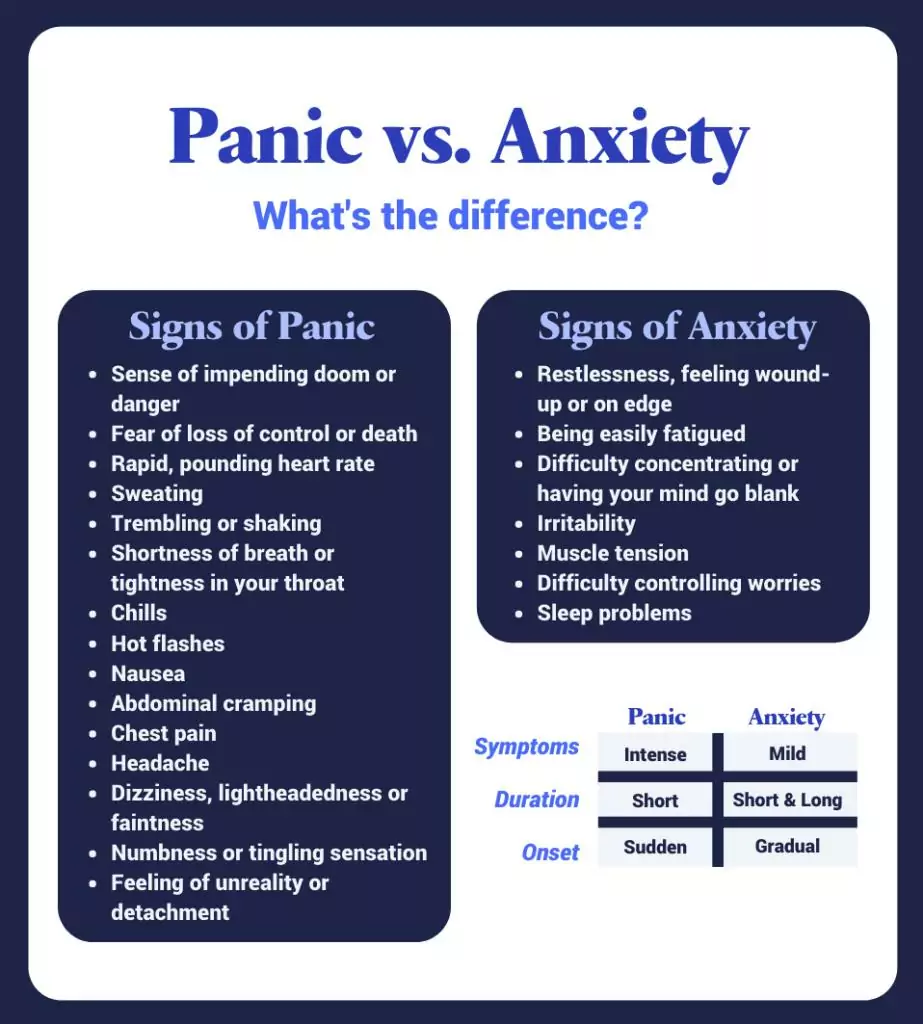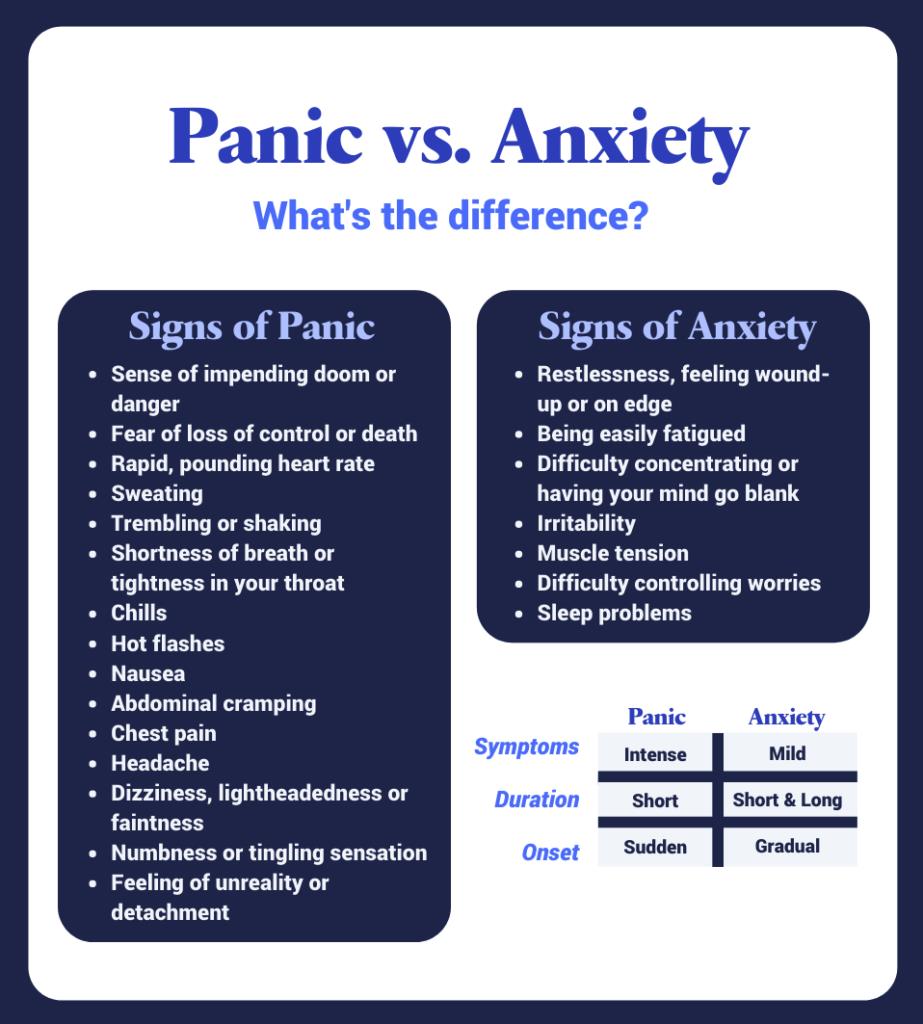Difference Between Anxiety Attack and Panic Attack

So, what is the difference between an anxiety attack and a panic attack? Why would someone experience one over another? What do they look like and feel like?
Anxiety attacks and panic attacks can look and feel very different. Sometimes it’s possible to mistake one for the other, but if you know the differences, it will help you understand how to respond to the attack.

The main difference is that an anxiety attack usually comes on slowly, over time. Panic attacks come on suddenly and rapidly. And they come on fast. If you know what the signs of each are (see below), then you’ll be able to recognize when it happens and how to deal with it appropriately.
Signs of an Anxiety Attack:
- Shaking, tremors and trembling can all be mild or severe. It might not be easy to stand or talk at times when you’re fiercely shocked.
- A racing heart or chest discomfort. – Pain that spreads to your neck and shoulders. You may be having a heart attack if you experience this pain in the center of your chest and have trouble breathing.
- Chest discomfort: can be felt as a tight band around your wardrobe that is sharp, painful, and in some cases mistaken for a heart attack.
- Hyperventilation occurs when your body breathes too quickly and the oxygen levels in your blood drop. You might feel short of breath, chest pains, a choking sensation, or even a full-blown panic attack.
- A feeling that you’re going crazy or losing control. If you’re having an anxiety attack, you’ll likely feel the urge to escape the situation or environment.
- You could also be feeling numbness, tingling sensations, chills, hot flashes, and sweats without a known medical reason.
Signs of a Panic Attack:
- Rapid heartbeat or palpitations. When you have a panic attack, you might feel your heart pounding, fluttering, or pounding inside your chest even if you have no prior health conditions, such as heart disease. The discomfort can be so severe that those who experience panic attacks think they have a heart attack, but the two are very different.
- Chest discomfort or pain with no known cause. The pain itself can feel like sharp chest pains, pressure, burning sensations, or even indigestion-like symptoms during a panic attack. Some people mistake this for a heart attack because they can’t think of an alternative reason.
- Hyperventilation can lead to a loss of consciousness and even seizures for people who are having a panic attack. This is dangerous and should be looked at by a medical professional immediately if it occurs, especially if it’s accompanied by chest pain or palpitations.
- A panic attack is a feeling that your body is losing control; you might shake uncontrollably, feel faint, be short of breath (even when recovering from hyperventilating), get chills, get hot flashes, sweat profusely (can be mistaken for heavy perspiration during a workout), or even become numb.
- A panic attack is also feeling that you’re about to die or pass out. This is why panic attacks are often considered worse than anxiety attacks – the feelings of losing control and death make them much more challenging to cope with. Those who experience a panic attack might think that they’re going crazy, losing control, or even dying – it’s all too real for those experiencing a panic attack.
Causes of Panic and Anxiety Attacks:
Anxiety Attack:
Anxiety attack is a term most commonly used about an intense episode of sudden onset of intense fear or apprehension about possible situations, events, or objects accompanied by physical manifestations.
Medical reasons for anxiety disorders can include hyperthyroidism, heart disease, heart attack, pheochromocytoma, medication side effects, caffeine overdose, drug interactions, sleep deprivation or insomnia, excessive alcohol intake, and even withdrawal from various substances.
Anxiety attacks are often accompanied by other mental health disorders, with most affected individuals experiencing one or more comorbid conditions.
Panic Attacks:
Panic attacks are sudden periods of extreme terror that strike out of the blue and create overwhelming feelings of apprehension and fear.
There are four main types of panic disorder, including up to 75% of people who experience them having at least one other mental disorder. A panic disorder can include phobias, depression, bipolar disorder, obsessive-compulsive disorder (OCD), posttraumatic stress disorder (PTSD), and generalized anxiety disorder (GAD).
Making the Diagnosis:
Many people suffer from anxiety and panic disorder, but it’s essential to know whether you’re suffering from one or another as they require different treatments.
- Age. Children are more often diagnosed with generalized anxiety disorder, where adults are more likely to suffer from social phobia, panic disorders, specific phobias, and obsessive-compulsive disorder (OCD).
- Trauma. People who live through traumatic experiences might develop posttraumatic stress disorder (PTSD), bringing on symptoms such as anxiety attacks. PTSD is often mistaken for panic disorders because the symptoms are similar.
- Genetics. Anxiety attacks and related conditions could be hereditary, although research hasn’t yielded any solid evidence.
- Medical causes. It’s possible to mistake an anxiety attack for a physical symptom, such as indigestion, low blood sugar, heart attack, or other severe conditions.
- Lifestyle. Anxiety disorders are often brought on by environmental factors, including stress at work or school, lack of sleep, poor eating habits, and excessive caffeine intake.
- Substance abuse. Alcohol, drugs, and even some medications can cause or worsen anxiety attacks. This is especially true with stimulants such as cocaine, amphetamines, caffeine, ephedrine, pseudoephedrine, methylphenidate (Ritalin), MDMA (Ecstasy).
- Medical conditions. Anxiety attacks have several medical causes, such as mitral valve prolapse, heart arrhythmia, anemia, hyperthyroidism, asthma, chronic obstructive pulmonary disease, diabetes, and epilepsy.
- Other psychiatric disorders. Severe panic attacks and anxiety could be a symptom of certain mental illnesses such as bipolar disorder or schizophrenia.
Risk factors of Panic Attacks vs. Anxiety Attacks:
Panic disorder is more often hereditary, but developing them in adulthood is also possible. Other factors that can increase your risk for panic attacks and anxiety are:
- Having a family history of mental health conditions like panic disorders, OCD or PTSD
- Being exposed to traumatic experiences (e.g., war, disasters)
- Experiencing ongoing serious stress
- (e.g., abuse, health problems)
- Having no close friends or confidants
- Experiencing ongoing sleep deprivation or insomnia
- Taking certain medications (e.g., amphetamines/stimulants, caffeine, corticosteroids)
- Using illegal drugs (e.g., cocaine, amphetamines, MDMA)
- Consuming excessive alcohol
- Having irregular, fast or slow heartbeats (e.g., mitral valve prolapse)
- Getting older increases the risk for panic disorders; it starts in late adolescence/early adulthood (15-24 years) and becomes common around 45 years old.
Treatment for Panic Attacks vs. Anxiety Attacks:
Depending on the circumstances you’re experiencing, panic attacks and anxiety are treated with medicine or therapy by a mental health professional.
Types of Treatment
Counseling and Cognitive-Behavioral Therapy (CBT) are effective treatment for panic attacks and anxiety, as well other mental disorders when combined. Both of these treatments are in the diagnostic and statistical manual to help those affected by anxiety attacks recognize harmful thoughts and behaviors that lead to the problem and develop coping skills.
Relaxation techniques -Breathing exercises can help reduce the physical symptoms associated with panic and anxiety attacks. They help with panic attack symptoms and are suitable for overall mental health.
Cognitive restructuring – This process teaches you to look at your thoughts in a more realistic, rational way. Changing the way you think about certain things makes it easier to develop healthier responses and behaviors.
Problem-solving – Sometimes, panic attacks or anxiety attacks are due to short-term problems in your life that you don’t feel equipped to handle. Therapy can teach you to develop problem-solving skills and help you healthily cope with such issues.
Role-playing – You can practice different stressful social or professional situations in the therapy sessions and learn how to respond effectively in those contexts.
Medication – Benzodiazepines may be prescribed to help with severe anxiety and mental health problems. They can reduce the frequency of panic attacks and lessen physical symptoms for a certain period, like excessive worry, but they must be used cautiously as they habit of being abused.
- Selected serotonin reuptake inhibitors (SSRIs) and serotonin-norepinephrine reuptake inhibitors (SNRIs) are antidepressants (SNRIs)
- Beta-blockers might assist with some physical symptoms, including a fast heart rate.
- Anti-anxiety medications, such as benzodiazepines, a sedative that can swiftly relieve symptoms
Home Remedies for Panic Attacks vs. Anxiety Attacks:
People who have panic attacks or anxiety attacks often turn to home remedies. These can include herbs, supplements, exercise, and other lifestyle changes that promote good mental health.
- Herbal remedies – Valerian root is an herb that’s used as a sedative because of the calming effect it has on your body. It might be helpful for people experiencing anxiety attacks and panic attacks or who struggle with high levels of stress.
- Chamomile: There’s evidence that this herb might be beneficial for anxiety and reduce the effects of some medications that contribute to stress (e.g., caffeine).
- Supplemental remedies – Vitamin D is essential for maintaining healthy moods in your body because it interacts with a neurotransmitter in your brain called serotonin. When you don’t have sufficient vitamin D levels, you might experience mood changes and low energy levels.
- Exercise – Although exercise can make some people feel anxious when they first start, regular physical activity that gets your heart rate up can help reduce anxiety.
- Focus on specific exercises that increase your heart rate, such as running or swimming. You can also try other forms of exercise, such as yoga and tai chi, which involve a series of gentle movements designed to help you relax.
- Lifestyle changes – Some changes you make to your lifestyle might positively affect anxiety or panic attacks. For example, you might find that reducing or quitting your caffeine intake can help ease anxiety.
- Eating a healthy diet – Eating balanced meals regularly each day can make it easier for your body to maintain its normal rhythms. Try cutting out junk foods and anything else that makes you feel anxious, including alcohol and cigarettes.
- Doing relaxation exercises before bedtime – Controlled breathing can help you wind down and relax before sleeping.
- Getting enough sleep and avoiding late-night activities – When you don’t get the right amount of sleep, your body’s stress response is triggered more easily. This means it’s harder to stay calm in stressful situations, which might make anxiety worse.
- Minimizing stress – If you’re able to recognize that your anxiety is the result of a stressful situation, it might be easier for you to do something about it.
- Limiting your caffeine intake – Caffeine is an anxiety-inducing drug that can make it harder for you to feel calm and relaxed throughout the day. Although caffeine consumption has been linked to an increased risk of panic attacks, quitting it altogether might not be the best approach.
- Eating regularly – Skipping meals is likely to worsen anxiety because your blood sugar levels drop, making it harder for you to feel calm.
Conclusion:
Panic and anxiety attacks are very similar in terms of symptoms, but a few key differences separate them. Most importantly, panic attacks involve more intense fear and a more out-of-control feeling than anxiety attacks do. A Panic attack may seem more life-threatening as well, driving some to seek medical attention.
In both cases, it’s essential not to ignore the signs of an attack, even if they are mild. Ignoring your symptoms may cause them to get worse over time, but getting the right help early on can make it easier to treat both conditions effectively.